[English] 日本語
 Yorodumi
Yorodumi- PDB-2nuu: Regulating the Escherichia coli ammonia channel: the crystal stru... -
+ Open data
Open data
- Basic information
Basic information
| Entry | Database: PDB / ID: 2nuu | ||||||
|---|---|---|---|---|---|---|---|
| Title | Regulating the Escherichia coli ammonia channel: the crystal structure of the AmtB-GlnK complex | ||||||
 Components Components |
| ||||||
 Keywords Keywords | TRANSPORT PROTEIN/SIGNALING PROTEIN / Membrane protein complex / nitrogen regulation / ammonia transport / TRANSPORT PROTEIN-SIGNALING PROTEIN COMPLEX | ||||||
| Function / homology |  Function and homology information Function and homology informationpositive regulation of nitrogen utilization / ammonium transmembrane transport / ammonium channel activity / regulation of nitrogen utilization / enzyme regulator activity / carbon dioxide transport / ATP binding / identical protein binding / plasma membrane / cytosol Similarity search - Function | ||||||
| Biological species |  | ||||||
| Method |  X-RAY DIFFRACTION / X-RAY DIFFRACTION /  SYNCHROTRON / SYNCHROTRON /  MOLECULAR REPLACEMENT / Resolution: 2.5 Å MOLECULAR REPLACEMENT / Resolution: 2.5 Å | ||||||
 Authors Authors | Conroy, M.J. / Durand, A. / Lupo, D. / Li, X.-D. / Bullough, P.A. / Winkler, F.K. / Merrick, M. | ||||||
 Citation Citation |  Journal: Proc.Natl.Acad.Sci.Usa / Year: 2007 Journal: Proc.Natl.Acad.Sci.Usa / Year: 2007Title: The crystal structure of the Escherichia coli AmtB-GlnK complex reveals how GlnK regulates the ammonia channel Authors: Conroy, M.J. / Durand, A. / Lupo, D. / Li, X.-D. / Bullough, P.A. / Winkler, F.K. / Merrick, M. | ||||||
| History |
|
- Structure visualization
Structure visualization
| Structure viewer | Molecule:  Molmil Molmil Jmol/JSmol Jmol/JSmol |
|---|
- Downloads & links
Downloads & links
- Download
Download
| PDBx/mmCIF format |  2nuu.cif.gz 2nuu.cif.gz | 582.8 KB | Display |  PDBx/mmCIF format PDBx/mmCIF format |
|---|---|---|---|---|
| PDB format |  pdb2nuu.ent.gz pdb2nuu.ent.gz | 479.3 KB | Display |  PDB format PDB format |
| PDBx/mmJSON format |  2nuu.json.gz 2nuu.json.gz | Tree view |  PDBx/mmJSON format PDBx/mmJSON format | |
| Others |  Other downloads Other downloads |
-Validation report
| Arichive directory |  https://data.pdbj.org/pub/pdb/validation_reports/nu/2nuu https://data.pdbj.org/pub/pdb/validation_reports/nu/2nuu ftp://data.pdbj.org/pub/pdb/validation_reports/nu/2nuu ftp://data.pdbj.org/pub/pdb/validation_reports/nu/2nuu | HTTPS FTP |
|---|
-Related structure data
| Related structure data | 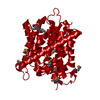 1u7gS S: Starting model for refinement |
|---|---|
| Similar structure data |
- Links
Links
- Assembly
Assembly
| Deposited unit | 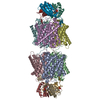
| ||||||||
|---|---|---|---|---|---|---|---|---|---|
| 1 | 
| ||||||||
| 2 | 
| ||||||||
| 3 |
| ||||||||
| 4 | 
| ||||||||
| 5 | 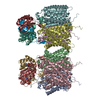
| ||||||||
| Unit cell |
|
- Components
Components
| #1: Protein | Mass: 43397.699 Da / Num. of mol.: 6 Source method: isolated from a genetically manipulated source Source: (gene. exp.)   #2: Protein | Mass: 12276.192 Da / Num. of mol.: 6 Source method: isolated from a genetically manipulated source Source: (gene. exp.)   #3: Chemical | ChemComp-ADP / #4: Water | ChemComp-HOH / | |
|---|
-Experimental details
-Experiment
| Experiment | Method:  X-RAY DIFFRACTION / Number of used crystals: 1 X-RAY DIFFRACTION / Number of used crystals: 1 |
|---|
- Sample preparation
Sample preparation
| Crystal | Density Matthews: 2.25 Å3/Da / Density % sol: 45.45 % |
|---|---|
| Crystal grow | Temperature: 298 K / Method: vapor diffusion, sitting drop / pH: 8 Details: 65% MPD, 100mM Tris pH8.0, VAPOR DIFFUSION, SITTING DROP, temperature 298K |
-Data collection
| Diffraction | Mean temperature: 100 K |
|---|---|
| Diffraction source | Source:  SYNCHROTRON / Site: SYNCHROTRON / Site:  SLS SLS  / Beamline: X06SA / Wavelength: 0.97972 Å / Beamline: X06SA / Wavelength: 0.97972 Å |
| Detector | Type: MARRESEARCH / Detector: CCD / Date: May 14, 2006 |
| Radiation | Protocol: SINGLE WAVELENGTH / Monochromatic (M) / Laue (L): M / Scattering type: x-ray |
| Radiation wavelength | Wavelength: 0.97972 Å / Relative weight: 1 |
| Reflection | Resolution: 2.5→50 Å / Num. obs: 105009 / Redundancy: 4.17 % / Rsym value: 0.0989 / Net I/σ(I): 13.3 |
| Reflection shell | Resolution: 2.5→2.6 Å / Redundancy: 4.21 % / Mean I/σ(I) obs: 3 / Rsym value: 0.536 |
- Processing
Processing
| Software |
| ||||||||||||||||||||||||||||||||||||||||||||||||||||||||||||||||||||||||||||||||||||||||||||||||||||||||||||||||||||||||||||||||||||||||||||||||||||||||||||||||||||||||||
|---|---|---|---|---|---|---|---|---|---|---|---|---|---|---|---|---|---|---|---|---|---|---|---|---|---|---|---|---|---|---|---|---|---|---|---|---|---|---|---|---|---|---|---|---|---|---|---|---|---|---|---|---|---|---|---|---|---|---|---|---|---|---|---|---|---|---|---|---|---|---|---|---|---|---|---|---|---|---|---|---|---|---|---|---|---|---|---|---|---|---|---|---|---|---|---|---|---|---|---|---|---|---|---|---|---|---|---|---|---|---|---|---|---|---|---|---|---|---|---|---|---|---|---|---|---|---|---|---|---|---|---|---|---|---|---|---|---|---|---|---|---|---|---|---|---|---|---|---|---|---|---|---|---|---|---|---|---|---|---|---|---|---|---|---|---|---|---|---|---|---|---|
| Refinement | Method to determine structure:  MOLECULAR REPLACEMENT MOLECULAR REPLACEMENTStarting model: PDB code 1U7G Resolution: 2.5→40 Å / Cor.coef. Fo:Fc: 0.956 / Cor.coef. Fo:Fc free: 0.909 / SU B: 21.864 / SU ML: 0.232 / Cross valid method: THROUGHOUT / ESU R: 1.121 / ESU R Free: 0.312 / Stereochemistry target values: MAXIMUM LIKELIHOOD / Details: HYDROGENS HAVE BEEN ADDED IN THE RIDING POSITIONS
| ||||||||||||||||||||||||||||||||||||||||||||||||||||||||||||||||||||||||||||||||||||||||||||||||||||||||||||||||||||||||||||||||||||||||||||||||||||||||||||||||||||||||||
| Solvent computation | Ion probe radii: 0.8 Å / Shrinkage radii: 0.8 Å / VDW probe radii: 1.4 Å / Solvent model: MASK | ||||||||||||||||||||||||||||||||||||||||||||||||||||||||||||||||||||||||||||||||||||||||||||||||||||||||||||||||||||||||||||||||||||||||||||||||||||||||||||||||||||||||||
| Displacement parameters | Biso mean: 29.201 Å2
| ||||||||||||||||||||||||||||||||||||||||||||||||||||||||||||||||||||||||||||||||||||||||||||||||||||||||||||||||||||||||||||||||||||||||||||||||||||||||||||||||||||||||||
| Refinement step | Cycle: LAST / Resolution: 2.5→40 Å
| ||||||||||||||||||||||||||||||||||||||||||||||||||||||||||||||||||||||||||||||||||||||||||||||||||||||||||||||||||||||||||||||||||||||||||||||||||||||||||||||||||||||||||
| Refine LS restraints |
| ||||||||||||||||||||||||||||||||||||||||||||||||||||||||||||||||||||||||||||||||||||||||||||||||||||||||||||||||||||||||||||||||||||||||||||||||||||||||||||||||||||||||||
| LS refinement shell | Resolution: 2.5→2.565 Å / Total num. of bins used: 20
|
 Movie
Movie Controller
Controller




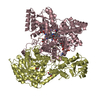

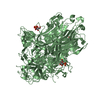


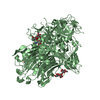
 PDBj
PDBj


